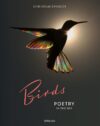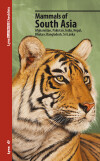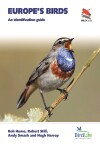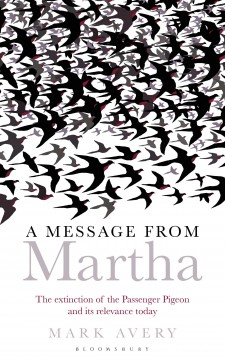 A Message from Martha: The Extinction of the Passenger Pigeon and Its Relevance Today
A Message from Martha: The Extinction of the Passenger Pigeon and Its Relevance Today
by Mark Avery
From Bloomsbury:
September 1st, 2014 sees the centenary of one of the best-documented extinctions in history the demise of the Passenger Pigeon. From being the commonest bird on the planet 50 years earlier, the species became extinct with the death in Cincinatti Zoo of Martha, the last of her kind.
A Message from Martha marks the centenary of that tragic event. Built around the framework of a visit to the pigeon’s former haunts in eastern North America by author Mark Avery, it tells the tale of the pigeon, and of Martha, and explores the largely untold story of the ecological annihilation of this part of America in the years between the end of the US Civil War and 1900. This period saw an unprecedented loss of natural beauty and richness, as forests were felled and the prairies were ploughed, swiftly to be replaced by a dustbowl, while wildlife was slaughtered indiscriminately. Written engagingly and with an element of travelogue as well as historical detective work, A Message from Martha is more than another depressing tale of human greed and ecological stupidity [emphasis added]. It contains an underlying message that we need to re-forge our relationship with the natural world on which we depend, and plan a more sustainable future. Otherwise the tipping point will be crossed and more species will go the way of the Passenger Pigeon. We should listen to the message from Martha.
I love the portion above that’s in bold. That’s why I’m looking forward to reading this book, it not only looks back at the Passenger Pigeion, but ahead to what we can learn from it.
A Message from Martha: The Extinction of the Passenger Pigeon and Its Relevance Today
by Mark Avery
Hardcover; 304 pages
Bloomsbury; August 26, 2014
ISBN: 978-1472906250
$22.00

Buy from Buteo Books
(based in the U.S.)
Buy from NHBS
(based in the U.K.)
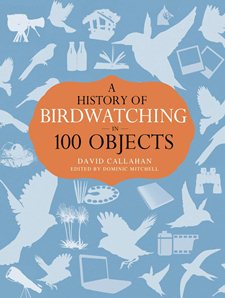 A History of Birdwatching in 100 Objects
A History of Birdwatching in 100 Objects
by David Callahan
From Bloomsbury:
This book looks at 100 items that have profoundly shaped how people watched, studied and engaged with the avian world. Each item contains around 500 words on a double-page spread and include an illustration of the object in question. The book includes the objects listed below as well as many more.The range of items is international and cross-cultural. Subjects include:
- An Egyptian ‘field guide’ [early tomb decorations of birds, identifiable as species]
- Ornithologiae libri tres: the first British bird guide [a 1676 publication that attempted to itemise all British birds known at the time]
- The Dodo specimen held at the Horniman museum
- Systema Naturae by Carl Linnaeus [the first-ever system of scientific names in 1758, and still the international standard today]
- The shotgun
- The book, The Natural History and Antiquities of Selborne by Gilbert White [1789]
- HMS Beagle [the ship on which Darwin made his ground-breaking discoveries]
- Aluminium bird rings [used to record movement and longevity of individuals and species]
- Many more modern innovations including walkie talkies, pagers, radio tags and apps
There’s an excellent review of this book by Donna Schulman at 10,000 Birds. Looks like an interesting conversation starter.
A History of Birdwatching in 100 Objects
by David Callahan
Hardcover; 224 pages
Bloomsbury; September 2, 2014
ISBN: 978-1408186183
$35.00

Buy from Buteo Books
(based in the U.S.)
Buy from NHBS
(based in the U.K.)
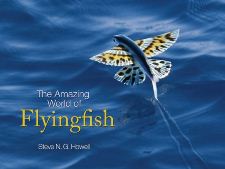 The Amazing World of Flyingfish
The Amazing World of Flyingfish
by Steve N. G. Howell
From Princeton University Press:
If you travel the open ocean anywhere in the tropics, you are very likely to see flyingfish. These beautifully colored “ocean butterflies” shoot out of the water and sail on majestic, winglike pectoral fins to escape from predators such as dolphins, swordfish, and tuna. Some can travel for more than six hundred feet per flight. Yet despite their prevalence in warm ocean waters and their vital role in the tropical food chain, surprisingly little is known about flyingfish–more than 60 species are said to exist, but nobody is sure of the number. This beautifully illustrated book presents flyingfish as you’ve never seen them before. It features more than 90 stunning color photos by renowned naturalist Steve Howell, as well as a concise and accessible text that explores the natural history of flyingfish, where they can be found, how and why they fly, what colors they are, what they eat and what eats them, and more.
The ideal gift for fish lovers, seasoned travelers, and armchair naturalists alike, this first-of-its-kind book provides a rare and incomparable look at these spectacular marine creatures.
- Presents flyingfish like you’ve never seen them before
- Features more than 90 stunning color images
- Explores the natural history of flyingfish, where to see them, how they fly, and more
- The ideal gift book for fish lovers, ecotravelers, birders, and armchair naturalists
No, this isn’t a bird book, but it is about some flying creatures that birders can often see! Watching flyingfish is one of my favorite things about pelagic trips. If you’d like to find out more about these strange fish, this tiny, but attractive, book is for you.
The Amazing World of Flyingfish
by Steve N. G. Howell
Hardcover; 64 pages
Princeton University Press; July 13, 2014
ISBN: 978-0691160115
$12.95
Buy from NHBS
(based in the U.K.)
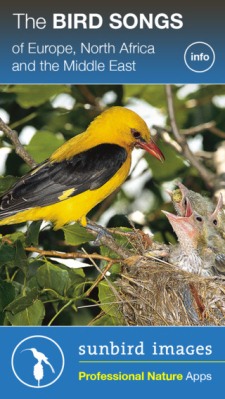 Bird Songs of Europe, North Africa and the Middle East
Bird Songs of Europe, North Africa and the Middle East
$79.99
From Edition AMPLE:
This is the professional App to the renowned reference work of Schulze and Dingler covering all 819 European species including all 2,817 songs and calls from the CDs and MP3-Discs. All species can be browsed according to their taxonomical classification and can thus be easily compared. Spectrograms to all sounds as well as high quality photographs and descriptions to each species are also included. As a novelty and practical advantage, multiple songs and calls of one species are arranged consecutively on separate tracks. Each track consists of several calls, which can independently be chosen and played immediately without the need to fast-forward. Explanations to all recordings and bird names are given in English.
Special features:
- 2817 songs & calls
- Includes 802 European species
- Spectrograms to all sounds
- Descriptions to all species
- 1350 photographs
- Create sighting lists and sort by place, date, group, and name
- Make notes for each bird spotted
- Display bird names in 18 languages
If you don’t already have this comprehensive sound collection – and have an Apple device – this looks like a convenient way to always have these songs at your fingertips.
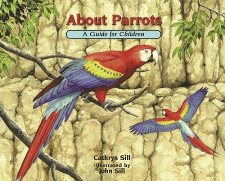 About Parrots: A Guide for Children
About Parrots: A Guide for Children
by Cathryn Sill and John Sill (Illustrator)
From Peachtree Publishers:
In this appealing addition to the acclaimed About… series, educator and author Cathryn Sill uses simple, easy-to-understand language to teach children what parrots are, how they look, how they move, what they eat, and where they live. Illustrator John Sill introduces readers to a variety of parrots, from the colorful Blue Lorikeets of the Polynesian Islands to the Rosy-faced Lovebirds of southwestern Africa. An afterword provides details on the parrots featured and inspires readers to learn more.
Not only is the art is gorgeous, but kids (and adults, too) are sure to learn a lot about these charismatic birds. Recommended for ages 3-7.
About Parrots: A Guide for Children
by Cathryn Sill and John Sill (Illustrator)
Hardcover; 48 pages
Peachtree Publishers; August 1, 2014
ISBN: 978-1561457953
$16.95
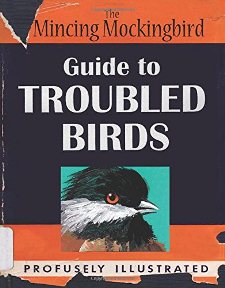 Guide to Troubled Birds
Guide to Troubled Birds
by The Mincing Mockingbird
From Blue Rider Press:
The Mincing Mockingbird Guide to Troubled Birds is an illustrated, pocket field guide that enables anyone to quickly identify psychotic, violent or mentally unstable bird species. Written in non-technical language for the layman, the guide describes where to find—or where to avoid—the most disturbed North American birds.
Throughout the book the reader will discover tales of murder, assault, mental breakdowns, obesity, drug abuse and infidelity among the birds. This guide is used and recommended by law enforcement agencies and ignored by leading ornithologists.
Obviously, this is a humor book. And a pretty funny one, too, if you’re a little on the demented side 🙂
Guide to Troubled Birds
by The Mincing Mockingbird
Hardcover; 64 pages
Blue Rider Press; June 12, 2014
ISBN: 978-0399170911
$15.95
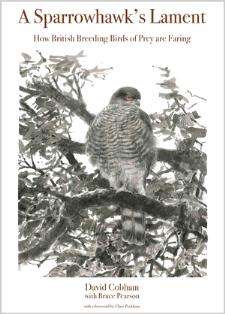 A Sparrowhawk’s Lament: How British Breeding Birds of Prey Are Faring
A Sparrowhawk’s Lament: How British Breeding Birds of Prey Are Faring
by David Cobham
From Princeton University Press:
Britain is home to fifteen species of breeding birds of prey, from the hedgerow-hopping Sparrowhawk to the breathtaking White-tailed Eagle. In this handsomely illustrated book, acclaimed British filmmaker and naturalist David Cobham offers unique and deeply personal insights into Britain’s birds of prey and how they are faring today. He delves into the history of these marvelous birds and talks in depth with the scientists and conservationists who are striving to safeguard them. In doing so, he profiles the writers, poets, and filmmakers who have done so much to change the public’s perception of birds of prey. Thanks to popular television programs, the Victorian myth that any bird with a hooked beak is evil has been dispelled. However, although there are success stories–five birds of prey that were extinct have become reestablished with viable populations–persecution is still rife: so much so that one bird of prey, the Hen Harrier, became extinct in England as a breeding bird in 2013.
Featuring drawings by famed wildlife artist Bruce Pearson, this book reveals why we must cherish and celebrate our birds of prey, and why we neglect them at our peril. In A Sparrowhawk’s Lament, you will learn how the perfection of the double-barreled shotgun sounded a death knell for British birds of prey in the nineteenth century, how the conscription of gamekeepers during two world wars gave them a temporary reprieve, how their fortunes changed yet again with the introduction of agricultural pesticides in the 1950s, why birds of prey are vital to Britain’s ecosystems and cultural heritage – and much more.
This looks like a good complement to Conor Mark Jameson’s Looking for the Goshawk.
A Sparrowhawk’s Lament: How British Breeding Birds of Prey Are Faring
by David Cobham
Hardcover; 256 pages
Princeton University Press; July 6, 2014
ISBN: 978-0691157641
$35.00

Buy from Buteo Books
(based in the U.S.)
Buy from NHBS
(based in the U.K.)
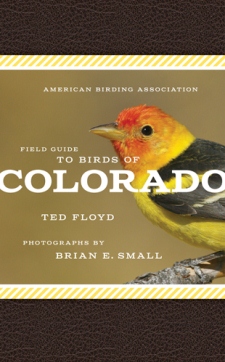 American Birding Association Field Guide to Birds of Colorado
American Birding Association Field Guide to Birds of Colorado
by Ted Floyd (Author) and Brian E. Small (Photographer)
From Scott & Nix, Inc.:
From the tiny rufous hummingbird to the majestic bald eagle, Colorado is home to more than 496 types of birds, making it one of the finest birding destinations in the world. Preserved habitats created by local, state, and national authorities have helped foster and protect nesting sites for hundreds of species, 235 of which are featured in their natural habitats, from Great Plains to Rocky Mountains, in this ornithological guide. The birds are organized by type from waterfowl to finches and appear in beautiful color photographs accompanied by clear and concise introductions, identification tips, and habitat and birdsong descriptions. The book also includes a complete state bird checklist and a directory of birding destinations, making this field guide the perfect companion for anyone interested in learning more about the natural history of Colorado and the diversity of the state’s birds and where to see them.
- 500 beautiful color photographs featuring over 250 bird species in natural habitats
- Clear and concise introduction, identification, habitat, and birdsong text
- Tips on when and where to see species
- Organized by type of bird from waterfowl to finches
- Complete state checklist, detailed state map, index, and quick index
- Perfect portable book for beginning to intermediate birders
This, the second in the ABA state field guide series, is very similar to its predecessor, American Birding Association Field Guide to Birds of New Jersey, in that it has nice photographs and good, state-specific text. On average, the text accounts are shorter and photos smaller than in New Jersey, which is disappointing, but overall it is a good choice for beginning and intermediate birders.
American Birding Association Field Guide to Birds of Colorado
by Ted Floyd (Author) and Brian E. Small (Photographer)
Flexicover with jacket; 320 pages
Scott & Nix, Inc.; June 2, 2014
ISBN: 978-1935622437
$24.95

Buy from Buteo Books
(based in the U.S.)
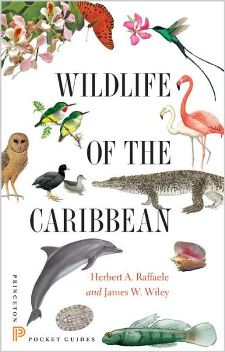 Wildlife of the Caribbean
Wildlife of the Caribbean
by Herbert A. Raffaele and James W. Wiley
From Princeton University Press:
This is the first comprehensive illustrated guide to the natural world of the Caribbean islands. It contains 600 vivid color images featuring 451 species of plants, birds, mammals, fish, seashells, and much more. While the guide primarily looks at the most conspicuous and widespread species among the islands, it also includes rarely seen creatures–such as the Rhinoceros Iguana and Cuban Solenodon–giving readers a special sense of the region’s diverse wildlife.
Each species is represented by one or more color photos or illustrations; details regarding its identification, status, and distribution; and interesting aspects of its life history or relationship to humans. In addition, an introductory section focuses on the unique characteristics of the Caribbean’s fauna and flora, the threats faced by both, and some of the steps being taken to sustain the area’s extraordinary natural heritage.
Wildlife of the Caribbean is the essential field guide for learning about the living wonders in this area of the world.
- The only guide of its kind for the Caribbean islands
- 600 detailed color images feature 451 amazing species
- Straightforward descriptions suitable for general audience
- Compact size makes the guide easy to carry
Birders will still want a dedicated bird field guide, like Birds of the West Indies (from which the bird illustrations here are taken). But this makes a nice “sampler” guide to other wildlife like plants, mammals, reptiles, amphibians, fish, coral, and shells. I’ll definitely have it with me on my next trip to the Caribbean.
Wildlife of the Caribbean
by Herbert A. Raffaele and James W. Wiley
Paperback; 304 pages
Princeton University Press; May 25, 2014
ISBN: 978-0691153827
$19.95

Buy from Buteo Books
(based in the U.S.)
Buy from NHBS
(based in the U.K.)
 The Owl Who Liked Sitting on Caesar: Living with a Tawny Owl
The Owl Who Liked Sitting on Caesar: Living with a Tawny Owl
by Martin Windrow
From Farrar, Straus and Giroux:
The story of an odd couple—a British military historian and the Tawny Owl with whom he lived for fifteen years.
Martin Windrow was a war historian with little experience with pets when he adopted an owl the size of a corncob. Adorable but with knife-sharp talons, Mumble became Windrow’s closest, if at times unpredictable, companion, first in a South London flat and later in the more owl-friendly Sussex countryside. In The Owl Who Liked Sitting on Caesar, Windrow recalls with wry humor their finer moments as well as the reactions of incredulous neighbors, the awkwardness of buying Mumble unskinned rabbit at Harrods Food Hall, and the grievous sense of loss when Mumble nearly escapes.
As Windrow writes: “Mumble was so much a part of my life in those days that the oddity of our relationship seldom occurred to me, and I only thought about it when faced with other people’s astonishment. When new acquaintances learned that they were talking to a book editor who shared a seventh-floor flat in a South London tower block with a Tawny Owl, some tended to edge away, rather thoughtfully . . . I tried to answer patiently, but I found it hard to come up with a short reply to the direct question ‘Yes, but . . . why?’; my best answer was simply ‘Why not?’”
In the spirit of J. R. Ackerley’s My Dog Tulip, Windrow offers a poignant and unforgettable reminiscence of his charmed years with his improbable pet, as well as an unexpected education in the paleontology, zoology, and sociology of owls.
This sounds very similar to Wesley the Owl. If it’s anywhere close to as good, it will be a good read.
The Owl Who Liked Sitting on Caesar: Living with a Tawny Owl
by Martin Windrow
Hardcover; 320 pages
Farrar, Straus and Giroux; June 10, 2014
ISBN: 978-0374228460
$26.00
Buy from NHBS
(based in the U.K.)
 A Message from Martha: The Extinction of the Passenger Pigeon and Its Relevance Today
A Message from Martha: The Extinction of the Passenger Pigeon and Its Relevance Today


 A History of Birdwatching in 100 Objects
A History of Birdwatching in 100 Objects The Amazing World of Flyingfish
The Amazing World of Flyingfish Bird Songs of Europe, North Africa and the Middle East
Bird Songs of Europe, North Africa and the Middle East About Parrots: A Guide for Children
About Parrots: A Guide for Children Guide to Troubled Birds
Guide to Troubled Birds A Sparrowhawk’s Lament: How British Breeding Birds of Prey Are Faring
A Sparrowhawk’s Lament: How British Breeding Birds of Prey Are Faring American Birding Association Field Guide to Birds of Colorado
American Birding Association Field Guide to Birds of Colorado Wildlife of the Caribbean
Wildlife of the Caribbean The Owl Who Liked Sitting on Caesar: Living with a Tawny Owl
The Owl Who Liked Sitting on Caesar: Living with a Tawny Owl



